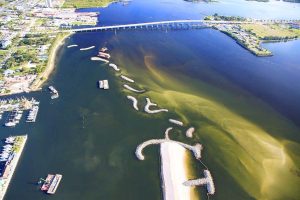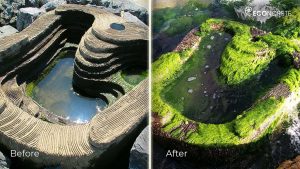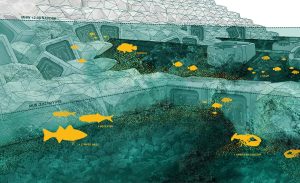
Is Everybody Going Green?
Published on March 28, 2023Sustainability — the beautiful buzzword of the century. To some people, it may mean reducing their carbon footprint as an individual or a company or being self-sufficient and growing their own food, or maybe it sounds like a load of bologna that is just the popular thing to say these days.
Sustainability is more of an ideology than a practice, although it can be incorporated into many aspects of life, from construction to agriculture to day-to-day activity. There are plenty of definitions of sustainability out there and one is no more correct than the other because there are different ways of interpreting it.
There are three pillars of sustainability: social, economic, and environmental. The social pillar outlines how people are responsible for how they act and treat their surroundings. In relation to a marina, this could include training staff on environmental health and safety to minimize spills or prevent toxins from entering the waterway. Or it could be as simple as treating everyone fairly and being kind since a little kindness can go a long way. From the perspective of the economic pillar, obviously, a business needs to make a profit to succeed, however, short-term solutions can be more trouble than they are worth.
Sustainable economics means investing in long-term solutions that protect both businesses and residents. The environmental pillar, which seems to get the most attention, includes a wide variety of factors, from monitoring emissions to preventing gas leaks, and reducing single-use plastics and other waste, to name a few.

The Social Pillar
Providing public access to the waterfront should be a priority for any new development or renovation. Parks and accessible recreation opportunities bring communities together and can bring tourism to new areas.
Sustainability-minded developers can incorporate fun playground elements, different types of recreational opportunities, and natural landscapes into their designs. When we give communities the opportunity to enjoy the waterfront, they learn more about the importance of sustainable resources and how they should respect and protect them.
One example of this is the SCAPE living breakwaters project in Staten Island, New York. There was a high level of community engagement and STEM education for local students as the project moved from design to construction. A focus is the Billion Oyster Project, which has a goal to restore oyster reefs in New York. Such projects teach the younger generations the importance of preserving the environment and rebuilding a thriving planet.
The Economic Pillar
When planning a project, it is important to consider its design life. This means, how long the finished product is meant to last. If the plan is for the project to be around for 30 or 50 years, it is important to consider the materials used and the exposure to salt water and waves. Planning for a design life of 50 years means designing to withstand a 50-year storm or a storm event that has

a one-in-50 chance of happening in a year. The projected sea level rise needs to be included, along with storm surge and tides, if applicable, to determine the worst case, highest water level. Sometimes it is not financially feasible to design for that worst case, so it seems like using a shorter design life is the only option. However, this is not a sustainable approach, because it does not consider the long-term environmental or economic effects if all the structures need to be replaced in 10 years. There are state and federal grants that provide funding for the renovation and restoration of sites that use sustainable construction and design. Often, they require green infrastructure or removal of contaminated soils, or even a provision for public waterfront access. These little things can add up to a very environmentally conscious facility.
Looking at the bigger picture is especially important in coastal projects. Let’s say there’s a house on a bluff along the coast of Lake Michigan that is suffering from extreme bluff erosion. The water removes layer after layer of sediment until the property is unsafe to live in. Most homeowners don’t want their house falling into the lake, so they hire someone to “fix” it. One solution could be a detached breakwater or a chain of segmented breakwaters, to slow down the sediment transport along the coast. However, building structures in one area affect much more than that one area. Depending on its orientation and proximity to the shoreline, it may stop large amounts of sediment from passing by, or it could do nothing at all. If it stops too much sediment from moving, though, it could starve the beach immediately downdrift of those structures. This shows why it is important to observe coastal processes as a system – and why it’s so expensive to throw some rocks in the lake. But of course, it is much more than that.
The Environmental Pillar
Environmental design techniques include hard or soft shoreline structures. “Gray” shoreline stabilization techniques include hard structures like a steel sheet pile wall, concrete bulkhead, or a breakwater made of large stones. Moving to “green” shoreline stabilization includes natural, organic measures such as wetlands, mangroves, reefs, and other features which create habitats and resilient shorelines. The type of stabilization varies greatly depending on the project and its location. Often, the best solution is a mix of hard and soft shoreline tactics. For example, reefs and mangroves are natural coastal buffers because they cause the waves to break before the water reaches the shoreline behind them. Restoring and replenishing mangroves and coral reefs that are diminishing quickly is almost always a good idea. However, the wave protection they provide might not always be enough, especially since it is important to plan for worsening storm conditions in the future. One solution is creating artificial reefs or submerged breakwaters, which are stronger and more resilient than natural reefs, so they can better protect the land behind them. Additionally, they can provide aquatic habitats similar to natural reefs.

Habitat creation must account for many factors to prevent wasteful investment. Planting some plants or throwing some rocks down for fish or birds is great, but if nothing comes to take advantage of the site, then it would all be for nothing. Environmental specialists determine the native plants of an area, the invasive species that need to be removed, and the habitat that is most appealing to avian, reptilian, and aquatic life. Proper research and implementation are more sustainable than generic solutions that may not achieve the project goal.
There are many ways to enhance traditional hard shoreline solutions with green infrastructure. Creating fish highways with rock formations or adding oyster or coral nurseries provide effective habitats for a variety of flora and fauna. ECOncrete® is an adaptive solution that provides environmentally sensitive concrete for marine construction. The admixture is safe for marine environments and the shapes and grooves of the blocks encourage biodiversity, without sacrificing the strength of the concrete. The blocks are designed to target specific organisms and encourage growth without compromising the structural integrity and protection that concrete infrastructure provides.
Implementation and Perks
It is understandable that the more sustainable and habitat-creating features of projects often cost more money. It takes time to research and plan a multipurpose project compared to the installation of a seawall which only serves the purpose of protecting the coast. There are people who understand this fact and provide resources and funding to encourage people to enhance their typical shoreline protection measures. Grants through the EPA, FEMA, NOAA, the DOT, and more, provide funding to keep water clean, hazards minimized, and coasts resilient. There are also clean marina programs, which encourage marina owners to install green infrastructure and keep their water and facilities clean. There is plenty of money to be spent on these promising practices, just do some research to find out which grant is the right choice for your facility.
The Future of Sustainability
So, what does the future hold? As electric cars get more popular, marinas start thinking about installing charging stations as part of their electrical upgrades. To reduce emissions, marinas might consider using man-powered boats for a season. Marinas should also consider ways to educate their customers and staff about the importance of environmental best management practices. Marina owners and operators are encouraged to look into programs and community initiatives to see how they can make a difference.
| Categories | |
| Tags |






